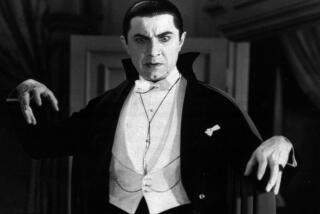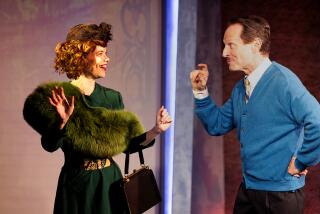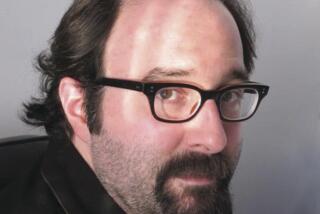Lost and Found In America
- Share via
These days, pop-cultural artifacts--from video games to reality television shows to novels in the form of comic books--come at us like a meteor shower as viewed in a fun-house mirror. Trying to assess their significance to our culture is like being inside one of those elevators in space that science writers invoke to explain time and motion in Einstein’s theory of relativity. We look out of our elevator and ask: Is pop entertainment approaching the theoretical limits of violence? Is meaning growing more absurd, or does it just seem that way because we ourselves are moving backward? And we make ourselves dizzy trying to find answers.
In such an atmosphere, it is a relief to experience the absolute gravity of Robert Warshow, the author of “The Immediate Experience: Movies, Comics, Theatre and Other Aspects of Popular Culture.” Nearly half a century ago, in October 1954, Warshow, a young magazine editor whose thoughtful essays on popular culture had been exciting the readers of Partisan Review, Commentary (where he worked) and other intellectual journals, applied for a Guggenheim Fellowship to write a book about film.
In his articulate and gracefully written project description, Warshow argued that serious film criticism tended to fall into two general types: aesthetic criticism, which stressed matters of technique, and sociological criticism, which judged the effect of the film on its audience. What Warshow proposed to do was to accept movies as being “the most highly developed and most engrossing of the popular arts” and to judge them in terms of their connection to the viewer. As he put it: “A man watches a movie, and the critic must acknowledge that he is that man.”
Warshow died the following year of a heart attack at the age of 37 and so never got to write his book. But he left behind enough essays to form a book published in 1962, the original version of “The Immediate Experience,” with an introduction by critic Lionel Trilling, and with Warshow’s Guggenheim application serving as its preface. In and out of print over the decades and highly prized by serious students of film, the book has been brought out in a new edition, with the addition of eight previously unpublished pieces by Warshow, a biographical essay by film critic David Denby and an epilogue by philosopher-turned-film critic Stanley Cavell.
Warshow covers an odd assortment of subjects in the volume, from the comic strip “Krazy Kat” (“a very sweet-tempered fantasy”), to the plays of Clifford Odets (“... the spectacular achievement which makes him a dramatist of importance is his truthful description of the New York Jews of the lower middle class.”), to E. B. White and the New Yorker magazine (“The New Yorker has always dealt with experience not by trying to understand it but by prescribing the attitude to be adopted toward it”).
Curiously, his 12 film essays are placed in the latter two-thirds of the book. They don’t examine most of the American movies you think of first when you recall the best ones of the late 1940s and early 1950s, like “On the Waterfront” or “It’s a Wonderful Life” or “From Here to Eternity” or “The Treasure of the Sierra Madre.” And where he does take up a particular film, like William Wyler’s “The Best Years of Our Lives” or Elia Kazan’s “Boomerang!” or Leo McCarey’s “My Son John,” he refuses to summarize their plots, as if we had them fresh in our minds from just last night.
But it isn’t for his assessment of familiar works that you read Warshow. Rather it’s to judge him on his own terms--to look at the man who is reacting to the work and to see what that work is doing to him. After a careful reading of “The Immediate Experience,” a clear image of that man remains somewhat elusive.
He’s most visibly present in the volume’s best piece, “Paul, the Horror Comics, and Dr. Wertham,” about his son’s casual attachment to comic books, like Mad and Tales From the Crypt, and Dr. Fredric Wertham’s famous crusade to have the publication of horror comics banned. Here Warshow shows us all the colors of his lovingly respectful relationship with his son, his wish that Paul would not be so attracted to such violent entertainment along with his concession that it probably isn’t doing him serious harm, and his judgment of Wertham’s analysis in his book “Seduction of the Innocent.”
With devastating effectiveness, he concludes that “Dr. Wertham’s world, like the world of comic books, is one where the logic of personal interest is inexorable, and ‘Seduction of the Innocent’ is a kind of crime comic book for parents, as its lurid title alone would lead one to suspect.”
Less available to our scrutiny is Warshow the anti-Stalinist. His despair over Soviet communism is extreme and serves him well as a tool of analysis in judging works such as Trilling’s novel “The Middle of the Journey,” Arthur Miller’s play “The Crucible,” the letters of Julius and Ethel Rosenberg and five of the famous movies on the Russian Revolution: Pudovkin’s “The End of St. Petersburg,” Dovzhenko’s “Earth,” Eisenstein’s “Potemkin,” “Ten Days That Shook the World” and “The General Line,” as well as “Tsar to Lenin,” a collection of authentic pictures of actual people and events made by perhaps 100 photographers. (About these films, he writes that so weary is he with the joke of human aspiration and wickedness they depict, he “would have given up all ironies, and the sense of tragedy and the sense of history along with them, just to have stupid, handsome Nicholas grinding his heel once more in the face of unhappy Russia.” Oh, for a return to basic indignation! he is saying.)
In his essay on “The Crucible” (currently enjoying a successful revival on Broadway), Warshow argues that the Salem witch trials were not in fact an act of persecution; they were the result of “a metaphysical error,” the judgment that certain people were damned. “The Salem trials were not political,” he writes, “and had nothing whatever to do with civil rights, unless it is a violation to hang a murderer,” which is what witches were judged to be. By alluding to them in his play and altering their historical meaning, he argues, Miller manages to seem to be saying something about McCarthyism without really saying anything.
Warshow writes: “Seeing all this on stage, we are free to reflect that something very like these trials has been going on in recent years [the early 1950s] in the United States. How much like? Mr. Miller does not say. But very like, allowing of course for some superficial differences: No one has been pressed to death in recent years, for instance. Still, people have lost their jobs for refusing to say under oath whether or not they are communists. The essential pattern is the same, isn’t it? And when we speak of ‘universal significance,’ we mean sticking to the essential pattern, don’t we? Mr. Miller is under no obligation to tell us whether he thinks the trial of Alger Hiss was a ‘witch trial’; he is writing about the Salem trials.”
The explanation for such disingenuousness, Warshow argues elsewhere, in “The Legacy of the ‘30s,” lies in our loss of a sense of reality. “The most important effect of the intellectual life of the ‘30s and the culture that grew out of it has been to distort and eventually to destroy the emotional and moral content of experience, putting in its place a system of conventionalized ‘responses,’” like applauding Arthur Miller for “speak[ing] out.” He continues, “In fact, the chief function of mass culture is to relieve one of the necessity of experiencing one’s life directly.” One might say that his mission in these essays is to get back in touch with real experience.
But what does he believe lies beyond the stultifying conflict over communism? Here he is less incisive. His dismantling of “The Best Years of Our Lives” is based on the shallowness of its message that the solution to facing postwar life is to embrace “simple” and “American” virtues. His analysis of the gangster “as tragic hero” is based in part on what he sees as the criminal’s willingness to say “no” to American optimism.
Such analyses are arresting enough, just as his explanation of Charlie Chaplin’s development as depending on the shifting balance between the individual and society is brilliant. But what, we have to ask, is his judgment of the deeper forces in American life, the ones that lie beyond the conflict between the right and the left? All he seems to have to say on this subject is that “the real causes” of what happened in the ‘30s “lay far back in the history of American culture and the social and psychological effects of industrial capitalism.” This portentous summing up scarcely connects us to the man watching the movies.
Perhaps Warshow was to some extent a victim of the cultural conflict he describes. He writes: “Even to stand out against this culture uncompromisingly--a thing very few were able to do; much more was required than just to be an anti-Stalinist--was only a partial victory. One kept one’s integrity, but this integrity became a purely personal satisfaction, without real weight--and the one assumption everyone shared was that weight was important. The culture remained and spread and entrenched itself, and its mere existence--this climate in which one had to live--was a standing threat to one’s personality, was in a sense a deep personal humiliation.”
Perhaps he was only half freed and would have accomplished the rest of his liberation by writing the book he proposed. Short of that, the essays in “The Immediate Experience” remain a beacon, a light to begin to show the way to how we might escape our present cultural confusions.
More to Read
Sign up for our Book Club newsletter
Get the latest news, events and more from the Los Angeles Times Book Club, and help us get L.A. reading and talking.
You may occasionally receive promotional content from the Los Angeles Times.








